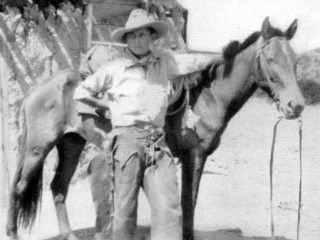
Clyde Kluckhohn biography
Date of birth : 1905-01-11
Date of death : 1960-06-28
Birthplace : Le Mars, Iowa
Nationality : American
Category : Arhitecture and Engineering
Last modified : 2010-10-08
Credited as : Anthropologist, social theorist, experiences in Navajo country
1 votes so far
Life
Clyde Kay Maben Kluckhohn was born on January 11, 1905, in Le Mars, Iowa, into the family of Clyde Clofford and Caroline Maben. His mother died at birth, and Kluckhohn was adopted by his maternal uncle. He started his education at school in Le Mars, then attended Culver Military Academy and in 1922, graduated from Lawrenceville School in New Jersey.
Kluckhohn matriculated at Princeton University, but due to poor health, was forced to take a break from studying and go to convalesce on a ranch in New Mexico owned by his relative, Evon Z. Vogt, a cultural anthropologist. During this period, he first came into contact with the neighboring Navajo and began a lifelong love of their language and culture. He wrote two popular books based on his experiences in Navajo country, To the Foot of the Rainbow (1927) and Beyond the Rainbow (1933).
Kluckhohn resumed study at the University of Wisconsin and received his B.A. in Greek in 1928. He then studied classics at Corpus Christi College, at the University of Oxford as a Rhodes Scholar in 1928-1930. He found classical studies too narrow for his broad interests, and considered a career in law. Finally he decided that anthropology was his best choice, with travel opportunities, time out of doors, and the largest of arenas of study—the human being. For the following two years, he studied anthropology at the University of Vienna and was exposed to psychoanalysis.
Kluckhohn was married in 1932, to Florence Rockwood, and received the post of assistant professor of anthropology at the University of New Mexico. He was also a research associate in archaeology at the School of American Research of the Museum of New Mexico. In 1934, he continued graduate work in anthropology at Harvard University, where he received his Ph.D. in 1936. He subsequently started to work at Harvard as a professor in Social Anthropology in 1946, staying with the Harvard Department of Social Relations for the rest of his life.
Kluckhohn received many honors throughout his career. In 1947, he served as president of the American Anthropological Association and became the first director of the Russian Research Center at Harvard. In the same year, his book Mirror for Man won the McGraw Hill award for best popular writing on science.
Clyde Kluckhohn died of a heart attack in 1960, in a cabin on the Upper Pecos River near Santa Fe, New Mexico. He was survived by his wife and son, Richard, both of whom became noted anthropologists.
Work
Clyde Kluckhohn remains renowned for his contributions to the ethnography of the Navajo American Indians. His interest in Navajo people started early in his life, in 1922, when he lived among them, learning their language and customs. From the summer of 1936, he started a serious ethnographic work with the Ramah Navaho. In his Navaho Witchcraft (1944), perhaps one of his finest works, Kluckhohn combined psychoanalytic, learning, and social structure theory in describing the customs of Navajo Indians. Overall, throughout his life, he built a respectable compilation of the different aspects of Navajo culture.
In 1949, Kluckhohn began a long-term study of what he and his colleagues called "Values Orientations" among five adjacent communities in Texas: Zuni, Navajo, Mormon, Spanish-American (Mexican-American), and Texas Homesteaders. A key methodological approach that he developed together with his wife, Florence Rockwood Kluckhohn, and colleagues Evon Z. Vogt and Ethel M. Vogt, among others, was the Values Orientation Theory. They believed that cross-cultural understanding and communication could be facilitated by analyzing a given culture's orientation to five key aspects of human life:
1. Human nature (people seen as intrinsically good, evil, or mixed);
2. Man-Nature relationship (the view that humans should be subordinate to nature, dominant over nature, or live in harmony with nature);
3. Time (primary value placed on past/tradition, present/enjoyment, or future/posterity/delayed gratification);
4. Activity (being, becoming/inner development, or doing/striving/industriousness); and
5. Social relations (hierarchical, collateral/collective-egalitarian, or individualistic).
Kluckhohn’s approach to anthropology was rather eclectic, using various methodological approaches in his studies. He wrote about the relations between psychology, biology, cultural anthropology, and other disciplines. He believed that people are the product of an interesting mix of biology and culture.
Kluckhohn's grand goal was to render the study of human behavior more scientific while retaining the richness and depth of understanding characteristic of the humanities. His work focused increasingly on the theory of culture and on the nature of values. Together with Alfred L. Kroeber (1952), he produced a thorough review of the conceptions of culture used by researchers, finding no less than 160 different definitions. These encompassed historical, behavioral, normative, functional, mental, symbolic, structural, and other dimensions of culture.
Kluckhohn suggested that "culture is to society what memory is to individuals" (Kluckhohn 1954). By this, he understood that culture is the product of what was found by experience to be worth transmitting to future generations.
Legacy
Kluckhohn’s eclectic approach to anthropology prevented him from differentiating his theory as a specific school of anthropology. Nevertheless, he was one of the most important anthropologists of the first half of the twentieth century, and many students were inspired by his ideas. His work, especially on the Navajo Indians and in the area of cultural theory, put him in the "Hall of Fame" of American anthropology.
The Values Orientation Method that he started was developed further by his wife Florence Kluckhohn and her colleagues and students.
















